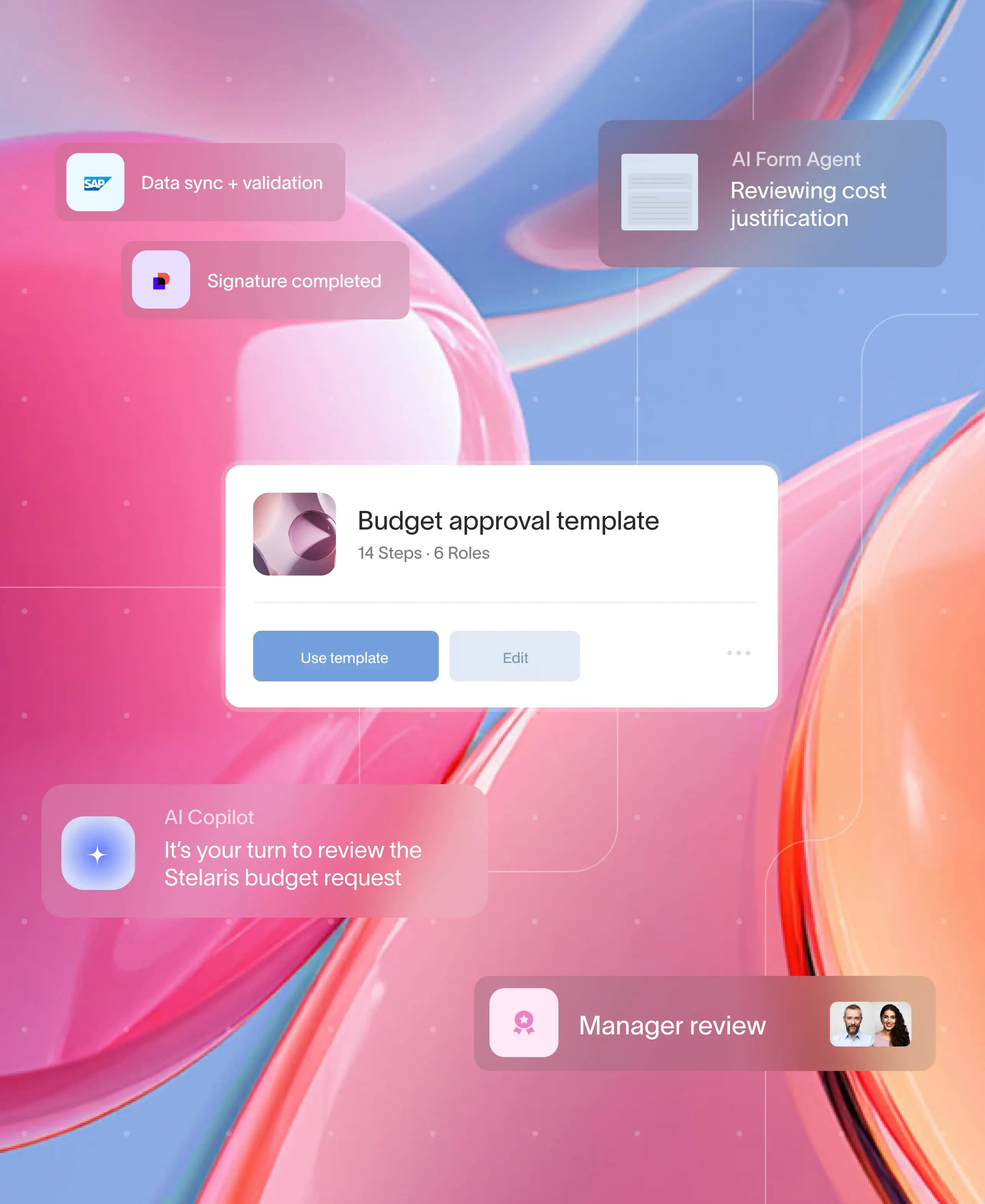
Think about the last time a simple business task spiraled into a time-consuming mess. Manual approvals, scattered communication, and disconnected tools – it all adds up. That’s where low-code business process automation comes in. It’s a smarter, faster way to streamline everyday workflows that keep your business moving.
Instead of relying on developers for every change, low-code process automation tools empower business teams to automate business processes with visual interfaces and prebuilt components. The result is faster turnaround times, less human error, and more agility across your organization.
In this guide, we’ll break down what low-code process automation actually is, how it works, and where it brings the most value. Whether you're looking to speed up approvals, onboard clients, or coordinate multi-party projects, low-code might be your biggest untapped advantage.
What is low-code business process automation
Low-code business process automation is exactly what it sounds like: automating tasks and workflows using platforms that require minimal coding. These platforms offer drag-and-drop interfaces, visual builders, and ready-to-use components so that business users can design, launch, and modify workflows with ease.
Let’s go one level deeper. Traditional business process automation requires extensive developer resources, slowing things down and creating a backlog. With low-code process automation, operations teams, project managers, and business leads can automate repetitive tasks, trigger actions across systems, and orchestrate entire processes without touching a line of code.
While low-code platforms offer flexibility for users with some technical understanding, no-code automation takes it even further—enabling non-technical users to build workflows with zero programming knowledge.
Low-code automation in practice
- A client onboarding flow gets triggered from a form submission, automatically assigning tasks, requesting documents, and setting deadlines.
- A contract approval process routes to the right stakeholders based on deal size—without anyone manually forwarding emails.
- A customer request updates CRM records, notifies account managers, and kicks off next steps instantly.
Low-code workflow automation is structured. It’s streamlined. And most importantly, it’s scalable.
How does low-code workflow automation work
At its core, low-code workflow automation replaces repetitive manual tasks with smart, rule-based workflows that run in the background. These workflows can be built visually, with logic that’s easy to follow – think "If this, then that" sequences, scheduled triggers, and condition-based actions – without the need to code every step from scratch.
Here's how low-code business process automation works:
- Visual workflow builder: You start with a blank canvas or a template. You can drag and drop elements like tasks, approvals, data inputs, or integrations with other systems.
- Rules and logic: You define how the workflow behaves – what triggers it, who gets assigned, and what happens next. This could be based on form inputs, file uploads, role permissions, or timeline conditions.
- Integrations: Most low-code business process automation software integrates seamlessly with your existing tools, so your data flows without disruption.
- Automation in motion: Once published, the workflow runs automatically. It notifies the right stakeholders, collects inputs, tracks progress, and logs everything for compliance and visibility.
Why does low-code automation matter in business
Because bottlenecks, delays, and siloed tasks don’t scale. Low-code automation lets teams move faster, adapt quicker, and spend less time chasing down follow-ups or fixing human errors. Whether you're a lean startup or an enterprise managing dozens of workflows, the flexibility to update processes on the fly is a real competitive edge.
Benefits of implementing low-code business process automation
Low-code automation isn’t just about speed – it’s about building a more responsive, efficient, and empowered organization. Here’s what that looks like in action:
1. Faster time to launch
With traditional coded automation, building and updating workflows can take weeks or longer. Low-code process automation platforms cut that down to days, sometimes even hours. Teams can iterate in real time, launching new processes as business needs evolve.
2. Less IT dependency
Business users can take the reins. That frees up IT teams to focus on complex technical challenges, not managing internal workflow tickets. It also reduces bottlenecks and decentralizes innovation across the organization.
3. Improved accuracy and consistency
Manual handoffs are prone to error. Low-code workflow automation ensures every task is completed in the right order, with required fields filled, approvals captured, and documentation stored automatically.
4. Better cross-team collaboration
Low-code tools come with built-in communication features or integrations with your existing tools. That means fewer email chains and more structured visibility into who’s doing what and when.
5. Scalable automation
As your business grows, so do your processes. Low-code systems can scale with you – no need to rebuild from scratch. You can clone workflows, tweak conditions, and adapt logic to new business units or markets.
6. Cost efficiency
Fewer hours spent on manual admin, less IT involvement, and fewer errors all add up to real savings. Low-code automation isn't just faster – it's leaner.
These benefits add up to more than just smoother operations – they create space for your team to focus on what drives growth, not just keeping the wheels turning.
Where low-code automation shines: 5 real-world use cases
Low-code process automation isn’t just for IT teams – it’s transforming how operations, finance, HR, and customer-facing teams get work done. Here are a few use cases where low-code makes an immediate impact:
1. Client onboarding
Customer onboarding is one of the most repetitive, multi-step processes in any service business. With low-code process automation, businesses can build workflows that trigger welcome emails, assign internal tasks, collect documents, and schedule meetings – all automatically and within a single flow. No more chasing paperwork or juggling tools.
2. Internal approvals
Whether it's purchase requests, contract reviews, or budget sign-offs, approvals can stall momentum. A low-code workflow routes each request to the right stakeholder based on predefined rules – like amount thresholds or department – while tracking progress and sending automatic reminders to keep things moving.
3. Contract execution and document collaboration
Client engagements often require multiple rounds of document sharing, revisions, and approvals. Low-code automation streamlines this process by triggering contract generation, routing documents to the right stakeholders for e-signatures, and maintaining version control—all within a unified flow. Clients stay informed, teams stay aligned, and nothing gets lost in back-and-forth emails.
4. Customer support escalations
With low-code automation, you can triage support tickets based on urgency or issue type, route them to the right team, and initiate follow-up workflows without delays or manual handoffs.
5. Vendor management
From collecting compliance documents to onboarding new vendors and managing contract renewals, low-code automation streamlines every step of the vendor lifecycle. You can trigger workflows when a new vendor is approved, assign reviews to procurement teams, and ensure all documentation is collected and tracked in one place—without chasing emails or files.
From external experiences to internal operations, low-code workflow automation gives every team a way to move faster and work smarter.
What makes low-code automation work: 5 key factors for a successful implementation
Adopting low-code automation isn’t just about picking a tool and building workflows. It’s about setting up your organization to scale those workflows sustainably. Whether you're starting small or rolling out automation across departments, here are a few factors that determine long-term success:
1. Start with clearly defined processes
Low-code process automation platforms can’t fix broken processes – they can only automate what exists. Before you digitize anything, make sure the workflow is clearly mapped out: who’s involved, what the steps are, and what the desired outcomes look like.
2. Align teams around ownership
One of the biggest advantages of low-code process automation is that it empowers business users. But with that power comes responsibility. Define who owns each workflow, who can make updates, and how changes are governed to avoid chaos later.
3. Choose tools that support integration
Your workflows shouldn’t live in a silo. Pick a low-code workflow platform that integrates with your existing systems so data flows smoothly and teams stay aligned.
4. Focus on the user experience
Automation should simplify things, not create new friction. Make sure the workflows are intuitive for both internal teams and external stakeholders. That means fewer clicks, clearer instructions, and visibility into what’s happening next.
5. Monitor, iterate, and optimize
No process stays perfect forever. Build in feedback loops. Track how workflows perform, where they stall, and how often they need to be adjusted. One of the strengths of low-code workflow automation is that it allows for continuous improvement without starting from scratch.
With the right foundation, low-code automation becomes more than just a tool – it becomes an operational strategy.
Moxo’s business process automation platform
While many platforms offer automation capabilities, Moxo’s service orchestration platform is built specifically for organizations that need to deliver services efficiently without coding.
With Moxo, businesses can design structured workflows that are fully branded, secure, and easy to deploy without writing a single line of code. Whether you're automating client onboarding, approvals, document workflows, or multi-party collaboration, Moxo enables you to streamline the entire lifecycle in one place.
Here’s how Moxo stands apart:
- No-code workflow builder: Moxo’s visual designer allows teams to create end-to-end workflows using drag-and-drop components. Assign tasks, schedule meetings, collect documents, trigger notifications, and more without any development required.
- Client-facing portals: Every workflow is delivered through a secure client portal where clients can complete tasks, sign documents, and stay informed without switching between tools or chasing updates.
- Built-in collaboration: Real-time messaging, comments, and file sharing are embedded directly into each step of the workflow, creating a seamless back-and-forth between clients and internal teams.
- Security-first architecture: Moxo is designed for regulated industries, with enterprise-grade security, audit trails, and role-based permissions that keep data protected and accessible only to the right people.
- Cross-device accessibility: Clients and team members can access their workflows from anywhere, making it easy to keep work moving on the go.
Whether you're a financial firm managing investor workflows, a legal team onboarding new clients, or a logistics provider coordinating with vendors, Moxo’s solution turns fragmented processes into frictionless experiences.
Don't worry about coding and streamline process automation with Moxo. Get started now!
Conclusion
Low-code business process automation isn’t about replacing humans, it’s about freeing them up to do the work that matters. It gives your team the tools to reduce manual effort, eliminate delays, and create more consistent outcomes without waiting on IT or rebuilding systems from scratch.
From faster onboarding to smoother internal approvals and multi-party coordination, low-code automation helps you operate with more control and less chaos. Moxo brings together no-code automation, collaboration, and client interaction into a single platform so you can deliver services with speed, precision, and professionalism at every step.
Don't worry about coding and streamline process automation with Moxo. Get started now.
FAQs
What is low-code business process automation?
Low-code business process automation is the use of low-code platforms to design, launch, and manage multi-step workflows across a business.
What is low-code business process automation software?
Low-code business process automation software enables companies to build workflows without traditional coding. These tools offer prebuilt templates, logic rules, and integration capabilities, allowing teams to digitize operations like onboarding, compliance, and service delivery faster and more efficiently.
What types of workflows can be automated with low-code solutions?
Low-code workflow automation can support a wide range of business needs: client onboarding, internal approvals, vendor processes, procurement, document routing, and even customer escalations.





